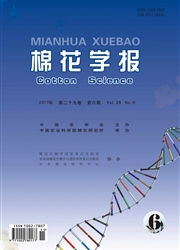

 中文摘要:
中文摘要:
以转基因棉花品种农大棉8号和鲁棉研28号为材料进行盆栽试验,设置正常处理(CK)、轻度胁迫(LS)、中度胁迫(MS)、重度胁迫(SS)和极度胁迫(ES)5个水分处理.结果表明:随着水分胁迫程度的加重,棉花幼苗的生长受到明显的抑制,2个品种的叶片相对含水率、叶水势、净光合速率(Pn)、光能利用率(LUE)、PSⅡ最大光化学效率(Fv/Fm)、PS Ⅱ光化学量子效率(φPS Ⅱ)、光化学猝灭系数(qP)呈下降趋势;气孔限制值(Ls)、水分利用率(WUE)和非光化学猝灭系数(NPQ)呈上升趋势.两品种的Pn和NPQ的MS、SS和ES与CK相比差异显著,不同测定时期各胁迫处理的平均Pn比CK分别下降了11.5%、18.1%、32.1%和38.1%;平均NPQ比CK上升了24.1%、50.9%、79.4%和145.1%.表明棉花幼苗期持续轻度水分胁迫对叶片光合能力无显著影响,但高于中度的持续水分胁迫会造成叶片光合能力下降和光抑制加重.
 英文摘要:
英文摘要:
The responses of leaf relative water content, leaf water potential, photosynthetic parameters, and chlorophyll fluores- cence parameters were studied with different Bt transgenic cotton cultivars (Nongdamian 8 and Lumianyan 28) under five differ- ent water stresses: normal irrigation (CK), light stress (LS), middle stress (MS), severe stress (SS), and extreme stress (ES). The results showed that the growth of cotton seedlings was inhibited significantly. Water stress resulted in a progressive decrease in relative leaf water content, leaf water potential, net photosynthetic rate (Pn), light use efficiency (LUE), maximum photosynthe- sis efficiency of PS II (Fv/Fm), actual photosynthesis efficiency of PS II in light (q~PS II), and photochemical quenching (QP). However, it led to an increase in the limiting value of stomata (Ls), water use efficiency (WUE), and non-photochemical quench- ing (NPQ). Overall, compared with CK, there were significant differences in Pn and NPQ between LS, MS, SS, and ES: from LS to ES, the average PN decreased by 11.5%, 18.1%, 32.1%, and 38.1%, respectively, whereas NPQ increased by 24.1%, 50.9%, 79.4%, and 145.1%, respectively. The experiments indicated that LS had little effect on photosynthetic characteristics during the cotton seedling stage, but greater water stress (higher than MS) resulted in the decline of photosynthetic capacity and photoinhi- bition of PS II.
 同期刊论文项目
同期刊论文项目
 同项目期刊论文
同项目期刊论文
 Effects of cadmium (Cd) on seedling growth traits and photosynthesis parameters in cotton (Gossypium
Effects of cadmium (Cd) on seedling growth traits and photosynthesis parameters in cotton (Gossypium 期刊信息
期刊信息
